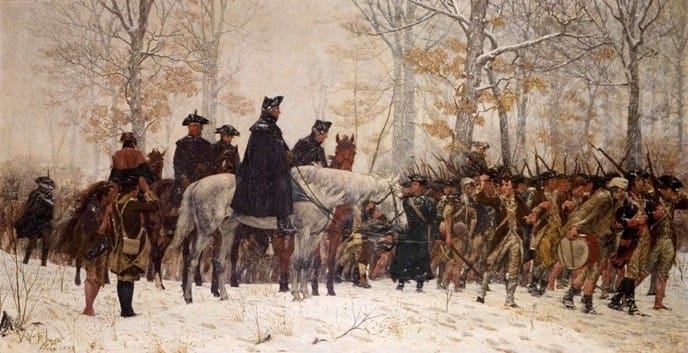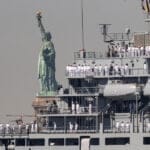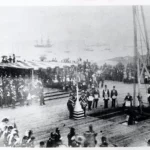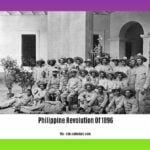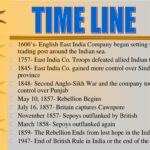Imagine thousands of soldiers, not yet hardened veterans, facing a brutal winter in Valley Forge. It’s 1778, and the Continental Army is teetering on the brink of collapse. Yet, amidst the freezing temperatures, lack of supplies, and plummeting morale, something extraordinary happens. This is where the unsung heroes of the American Revolution – the non-commissioned officers (NCOs) – emerge, ultimately shaping the future of the United States Army.
History of the NCO: 1700 Valley Forge
The winter of 1778 at Valley Forge was a crucible for the Continental Army. Facing not only the British but also starvation, disease, and despair, the fledgling army was in desperate need of a change. Enter Friedrich von Steuben, a Prussian military officer with a keen understanding of discipline and training. Recognizing the potential within these struggling soldiers, von Steuben arrived with a radical concept: standardized training.
Von Steuben’s training was far more than just teaching men how to shoot. He drilled the soldiers relentlessly, emphasizing discipline, obedience, and cohesive action. This intensive training, much like a crash course in soldiery, began to transform the army. They began to look, act, and fight as a united force.
However, von Steuben couldn’t oversee every detail. This is where the NCOs came in. Sergeants, corporals, and other enlisted leaders, these NCOs bridged the gap between officers and the rank and file. They enforced von Steuben’s training, ensuring orders were followed, and perhaps most importantly, kept spirits from breaking under unimaginable hardship.
The NCOs at Valley Forge were more than just drill instructors; they were mentors, problem solvers, and the glue that held the army together. They tackled disputes, ensured basic needs were met, and provided a sense of leadership when it was most needed.
The legacy of these Valley Forge NCOs resonates even today. Their dedication, leadership, and unwavering commitment in the face of adversity are the very cornerstones of NCO training in the modern US Army. We continue to learn about these pivotal figures through ongoing research, uncovering their stories of resilience and their invaluable contributions to the birth of a nation.
What Happened at Valley Forge to the Continental Army?
The winter of 1777-1778 at Valley Forge was a period of immense suffering and transformation for the Continental Army. Thousands of soldiers huddled in crude huts, battling not only the biting winter wind but also crippling shortages of food, clothing, and medicine. Diseases like typhoid and pneumonia spread rapidly through the camp, weakening an already vulnerable force. It’s estimated that over 2,000 soldiers perished during those grueling six months, succumbing to disease and malnutrition.
General George Washington, leading an army on the verge of collapse, faced an almost insurmountable task. Maintaining morale and discipline amidst such deprivation was a constant struggle. Yet, Washington persevered, sharing in his men’s hardships and tirelessly petitioning the Continental Congress for support.
Baron von Steuben’s arrival at Valley Forge marked a turning point. Recognizing the dire need for structure and training, he implemented a rigorous program, teaching the soldiers everything from basic formations to the intricacies of musketry. Under von Steuben’s watchful eye, farmers, blacksmiths, and shopkeepers who had taken up arms for their freedom began to evolve into a disciplined fighting force.
What’s often overlooked is von Steuben’s recognition of the importance of non-commissioned officers (NCOs). He empowered these sergeants and corporals, granting them the authority and responsibility to train and lead their fellow soldiers.
Valley Forge’s impact resonated far beyond that harsh winter. The Continental Army that emerged from the encampment was battle-hardened, instilled with newfound discipline and determination. Whether this experience was essential for their eventual victory in the American Revolution is a subject of ongoing historical debate. However, it’s undeniable that Valley Forge forged the Continental Army into a force capable of challenging the might of the British Empire.
Ongoing archaeological work at Valley Forge continues to reveal new evidence about the lives of those who endured that winter. We are gaining a deeper understanding of their living conditions, diets, and even their leisure activities, shedding light on the human cost of the revolution and the remarkable resilience of those who fought for American independence.
Valley Forge stands as a testament to the power of hope and determination, even in the darkest of times. It reminds us that the human spirit, when pushed to its limits, can overcome seemingly insurmountable obstacles and achieve extraordinary things.
When Did the History of the NCO Begin?
Pinpointing the exact moment the NCO emerged as a distinct military role is challenging. While the American NCO is formally recognized as coming into being alongside the Continental Army in 1775, their origins are rooted in earlier military traditions. It’s likely that the Continental Army, observing the practices of other armies, recognized the need for a similar role to bridge the gap between officers and enlisted personnel.
Rather than adopting a single model, the American NCO role evolved by incorporating elements from various systems, including British, French, and Prussian military structures. A significant milestone in this development was the introduction of Baron von Steuben’s “Blue Book” in 1778. This training manual, specifically designed for NCOs, emphasized their critical role not only as disciplinarians but also as instructors. They were tasked with molding raw recruits into capable soldiers and instilling the professionalism that would come to define the American soldier.
From those early days to the present, the NCO has served as the backbone of the U.S. military. Leading from the front, mentoring new generations, and ensuring the smooth operation of their units, NCOs embody the accumulated experience and traditions of the armed forces.
Who Trained and Organized the Continental Army at Valley Forge?
Picture the Continental Army at Valley Forge in the winter of 1777-1778. These were men fighting for their freedom from Great Britain, yet after a series of defeats, their spirits were low, and their training was disorganized and inadequate. This is where Friedrich Wilhelm Baron von Steuben, a Prussian military officer, stepped in, bringing with him a wealth of experience and a determination to shape the Continental Army into a formidable force.
Von Steuben, recognizing the potential within the ranks, immediately set about bringing structure and discipline to the demoralized troops. He created the “Blue Book,” a revolutionary training manual that introduced standardized drills, formations, and battlefield tactics. Under his guidance, soldiers who were once farmers, blacksmiths, and shopkeepers learned to march in unison, handle their weapons with precision, and fight as a cohesive unit.
General George Washington, commander-in-chief of the Continental Army, played a crucial role in facilitating von Steuben’s success. Washington understood the dire need for the rigorous training von Steuben offered, providing him with the authority and support necessary to transform the struggling army.
The transformation, however, was far from easy. The soldiers endured freezing temperatures, limited supplies, and the challenges of learning a new way of fighting in the midst of winter. Driven by their desire for freedom and inspired by von Steuben’s leadership, they persevered.
The impact of the training at Valley Forge was undeniable. The Continental Army emerged as a more disciplined and effective fighting force, more prepared to confront the British. Von Steuben’s “Blue Book” continued to influence American military training for decades and played a pivotal role in shaping the United States Army we know today.
Key Takeaways:
- Friedrich Wilhelm Baron von Steuben, a seasoned Prussian military officer, was instrumental in training and organizing the Continental Army at Valley Forge.
- Von Steuben’s innovative “Blue Book” established standardized training methods, instilling discipline and cohesion within the army.
- General George Washington’s leadership and strategic decision to encamp at Valley Forge proved essential, allowing for the army’s transformation.
- The rigorous training endured at Valley Forge was a turning point in the Revolutionary War, ultimately enabling the Continental Army to challenge the mighty British Army.
For further exploration:
- The Valley Forge Encampment (https://www.history.com/topics/american-revolution/valley-forge) provides a comprehensive overview of this pivotal period in American history.
The transformation at Valley Forge extended beyond drills and formations. It was about fostering morale and instilling a sense of pride. These men were no longer a collection of individuals; they were the Continental Army, united in their fight for independence.
Who Were the Major Generals at Valley Forge?
While General George Washington led the Continental Army at Valley Forge, a number of key figures, regardless of their exact rank, played crucial roles in shaping the army during that challenging winter. It’s important to note that the Continental Army’s ranking system at the time differed from today’s, and influence wasn’t always directly tied to formal rank.
Here are some of the individuals who were instrumental in navigating the challenges at Valley Forge:
- Marquis de Lafayette: A young French aristocrat deeply committed to the cause of American liberty, Lafayette served not only as a military commander but also as a vital liaison. He leveraged his connections in France to secure desperately needed aid for the struggling Continental Army.
- Friedrich Wilhelm von Steuben: This Prussian officer brought a wealth of experience and a keen understanding of discipline and efficiency to Valley Forge. Recognizing the potential within the Continental Army, he set about transforming them into a force capable of standing against the British army. His rigorous training regimen, outlined in his “Blue Book,” proved instrumental in their eventual success.
- Nathanael Greene: One of Washington’s most trusted advisors, Greene was renowned for his strategic thinking and logistical expertise. Initially tasked with the challenging role of Quartermaster General, he was responsible for supplying the army amidst constant shortages. He would later prove himself a capable battlefield commander.
- Anthony Wayne: Known for his aggressive fighting spirit, “Mad” Anthony Wayne was a Pennsylvanian general who was known to fight alongside his men. He played a critical role in boosting morale and instilling a fighting spirit within his division, a quality that would prove essential in later battles.
- James Mitchell Varnum: A lawyer and politician before the war, Varnum’s commitment to the cause led him to command a brigade at Valley Forge. His story exemplifies how the American Revolution went beyond the battlefield, encompassing the formation of a new nation. Varnum went on to serve in the Continental Congress after the war.
These men represent only a fraction of those who demonstrated leadership and courage during the harsh winter at Valley Forge. Their contributions, along with the sacrifices of countless soldiers, helped to mold the Continental Army into a force capable of securing American independence.
It’s important to approach history with the understanding that it is complex and multifaceted. New evidence and interpretations continuously shape our understanding of events like Valley Forge. While these men played significant roles, countless others contributed to the war effort. Exploring their stories allows for a more complete and nuanced understanding of the American Revolution.
What Is an Interesting Fact About Valley Forge?
While the hardships faced by the Continental Army at Valley Forge are well-documented, the strategic significance of the location is often overlooked. The area’s name, “Valley Forge,” hints at a crucial element of the troops’ survival: an iron forge.
Before the war, a working iron forge in the area produced a wide range of metal goods. When the Revolution began, this forge became a lifeline for the Continental Army, providing weapons, tools, and equipment. It wasn’t merely a small operation; it was a significant source of essential supplies. Washington’s decision to establish winter camp at Valley Forge was not only about finding shelter but also about maintaining proximity to this vital resource. The iron forge likely played a crucial role in the army’s ability to weather the brutal winter of 1777-1778.
Considering the dire need for weapons and tools, the significance of the iron forge becomes clear. It underscores the strategic thinking involved in even the simplest decisions, such as choosing where to camp, during wartime.
What Did George Washington Say at Valley Forge?
Valley Forge was undoubtedly a trying time for George Washington and his troops. The freezing temperatures, lack of supplies, and bleak outlook for the Revolution presented immense challenges. While we may not have transcripts of casual conversations around campfires, we do have Washington’s letters from Valley Forge, offering a glimpse into the dire circumstances and the powerful words he used to rally his men.
In his letters, we find lines like “We are in a critical situation, and our only hope is in a speedy and powerful reinforcement.” These words weren’t just a request for additional troops; they were a desperate plea for survival.
Washington’s letters weren’t limited to military superiors. He also wrote to the leaders of individual states, his frustration evident as he urged them to put aside their differences and act as a unified nation, especially with the British posing an imminent threat. Remember, the idea of a United States was still fragile at this point in history.
Beyond the calls for aid, another message resonates throughout Washington’s writings from Valley Forge: unwavering resolve. He consistently reminded his audience that surrendering was not an option, emphasizing that they were fighting for something far greater than a single battle; they were fighting for a cause worth sacrificing for.
Valley Forge transcended its identity as a brutally cold winter camp; it was a pivotal turning point. The Continental Army arrived disorganized and demoralized, but they emerged tougher and more unified. Historians often cite the spirit forged at Valley Forge as a key factor in the eventual American victory.
While we may not know the exact words spoken around campfires, Washington’s writings from Valley Forge reveal a leader grappling with urgency, frustration, and an unyielding belief in the fight for independence. These weren’t just words on paper; they were the words of a leader determined to see his nation born.
What Happened to the Continental Army at the Valley Forge Encampment?
The winter encampment at Valley Forge was more than just drills and battles for the Continental Army; it was a fight for survival. Imagine thousands of soldiers battling not only the frigid winter of 1777-1778 but also severe shortages of food, warm clothing, and medicine. Diseases spread rapidly, and the overall health of the army declined drastically.
It’s estimated that 2,000 soldiers died at Valley Forge, succumbing to disease and malnutrition. However, the Continental Army, instead of collapsing under these hardships, used the experience to become stronger. They trained relentlessly, even in the harshest conditions, and slowly but surely, they transformed into a more disciplined and unified fighting force.
General George Washington played a pivotal role in this transformation. His unwavering dedication to his troops and his refusal to give up, even in the face of seemingly insurmountable odds, inspired them to keep fighting.
The arrival of aid from overseas, particularly from France, provided a much-needed boost to the struggling army. This support, coupled with the unyielding spirit of the soldiers, allowed them not only to survive Valley Forge but to emerge stronger and more determined.
Valley Forge remains a powerful symbol of the American spirit—the ability to endure hardship and emerge stronger. It serves as a testament to the courage, resilience, and determination of those who fought for their nation’s independence.
What Did the Soldiers at Valley Forge Eat?
The harsh conditions at Valley Forge are well-documented, but what did the soldiers actually eat to survive that brutal winter? Historians have pieced together a picture of their diet from diaries, letters, and official records, and the reality was far from ideal.
On paper, Continental Army soldiers had a seemingly adequate diet. Daily rations were supposed to include meat (beef, pork, or fish), bread or flour, peas or beans, and a weekly allotment of butter and vinegar. They also received a daily ration of whiskey or beer, perhaps to boost morale or simply to dull the pangs of hunger.
However, receiving those rations was a different story. Supply lines were inconsistent at best and often completely broken. Soldiers frequently went days without meat and even longer without other essential provisions. Imagine facing freezing temperatures, exhausted from training, with nothing to satisfy a rumbling stomach. This was the reality for many at Valley Forge.
A critical shortage of wheat flour, a staple ingredient, forced soldiers to rely on “firecakes.” These flat, hard crackers, cooked in iron kettles over open fires, may not sound entirely unappetizing, but imagine eating them day after day. To make matters worse, poor storage conditions often resulted in contamination from weevils or maggots.
The arrival of Christopher Ludwick, a German baker, provided a much-needed solution to the dwindling bread supply. Appointed as the “superintendent of bakers” by Congress, Ludwick promised to deliver 135 pounds of bread for every 100 pounds of flour he received—and he delivered. His bread became a lifeline for the starving troops, likely saving countless lives.
Here are some additional insights into the food situation at Valley Forge:
- Family Matters: Many soldiers were accompanied by their wives and children, known as “camp followers.” These women and children played an essential role, cooking, hauling firewood, and carrying water, serving as the unsung heroes who kept the camp running.
- Earthen Ovens: Demonstrating remarkable resourcefulness, soldiers dug shallow pits that served as makeshift ovens. These “earthen kitchens” conserved precious firewood and made cooking a bit easier.
- A Heavy Toll: The constant hunger and malnutrition took a significant toll on the soldiers, both physically and mentally. Maintaining morale and focus when constantly cold, exhausted, and hungry was an immense challenge.
The Bottom Line
The story of food at Valley Forge is one of resilience, hardship, and the will to survive. While official rations appeared sufficient on paper, the reality was much harsher. Soldiers faced constant food shortages, forcing them to rely on meager and often unappetizing substitutes. Yet, even amid these challenges, there were glimmers of hope, such as the arrival of Christopher Ludwick and the unwavering support of camp followers. These stories underscore the human cost of war and the immense sacrifices made by those who endured unimaginable conditions at Valley Forge.
How Did Baron von Steuben Help the Continental Army?
The Continental Army, facing the mighty British Army, was in dire need of structure and organization. Their lack of standardized training and discipline put them at a significant disadvantage. Baron von Steuben, a Prussian military officer who arrived in 1777, recognized this weakness and set about transforming the Continental Army into a formidable fighting force.
General Washington immediately recognized von Steuben’s potential and put him to work. His most significant contribution was the creation of the “Blue Book,” a comprehensive training manual that covered everything from basic drills to complex battle tactics. This manual, far from a dull and tedious document, became the definitive guide for soldiers looking to excel in the Continental Army.
Von Steuben’s impact extended far beyond teaching soldiers how to fight. He understood that a successful army required a complete overhaul. He helped to streamline the supply chain, ensuring soldiers had the ammunition and food they needed. He instilled a sense of discipline, recognizing that a well-organized army was a force to be reckoned with. Under his guidance, the artillery and cavalry also became more effective and organized units.
The impact of von Steuben’s reforms was significant. The Continental Army transformed from a group of enthusiastic but disorganized volunteers into a force capable of challenging the best the British had to offer. It’s no exaggeration to say his contributions played a vital role in the American victory.
Without von Steuben’s intervention, the Continental Army might have remained an outmatched underdog. Instead, they transformed into a disciplined and cohesive fighting force, and that transformation made all the difference in the fight for independence.
What Happened at Yorktown?
The siege of Yorktown wasn’t just another battle; it was the decisive confrontation that signaled the end of British rule in the American colonies. By September 1781, General George Washington, along with his French allies led by General Rochambeau, had devised a plan to trap the British forces under the command of General Cornwallis at Yorktown, Virginia.
The combined American and French forces swiftly surrounded Yorktown, cutting off supply lines and preventing reinforcements from reaching Cornwallis and his army. As weeks passed, the pressure on the British intensified. Although they fought bravely, their situation became increasingly untenable.
On October 19, 1781, Cornwallis, realizing the futility of further resistance, made the difficult decision to surrender to General Washington. This surrender was a momentous occasion, marking a turning point in the war and setting the stage for the American victory.
The surrender at Yorktown paved the way for peace negotiations between the Americans and the British. While negotiations were lengthy, they eventually culminated in the signing of the Treaty of Paris in 1783, officially recognizing the United States as an independent nation, free from British rule.
Yorktown, however, was more than a display of military strategy. It represented the culmination of perseverance, strategic alliances, and above all, the unwavering fight for freedom.
Internal Links:
To gain a deeper understanding of the evolution of the guayabera, dive into its captivating history of the guayabera.
Delve into the intriguing narrative behind the Halligan bar by embarking on a journey through its rich history of the halligan bar.
Uncover the enigmatic origins of the MacGregor clan through a captivating exploration of its historical tapestry history of the macgregor clan.
- Unveiling the Enigma: Mansoureh Khojasteh Bagherzadeh’s Public Appearances & Private Life in Iran - July 18, 2025
- Unveiling the Mystery: Mansoureh Khojasteh Bagherzadeh’s Husband: A Rare Glimpse into a Private Life - July 18, 2025
- Unveiling Masoud Khamenei’s Mother: Power, Influence, and Iran’s Future - July 18, 2025
